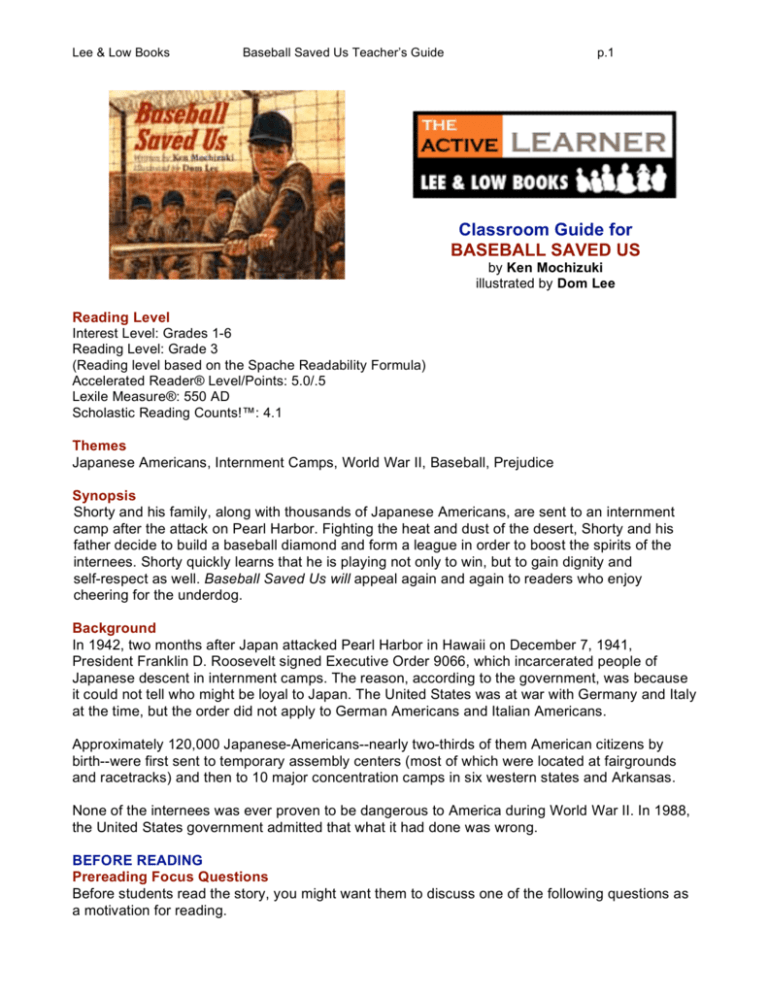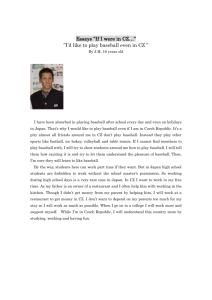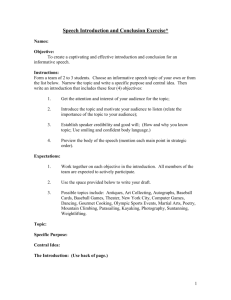
Lee & Low Books
Baseball Saved Us Teacher’s Guide
p.1
Classroom Guide for
BASEBALL SAVED US
by Ken Mochizuki
illustrated by Dom Lee
Reading Level
Interest Level: Grades 1-6
Reading Level: Grade 3
(Reading level based on the Spache Readability Formula)
Accelerated Reader® Level/Points: 5.0/.5
Lexile Measure®: 550 AD
Scholastic Reading Counts!™: 4.1
Themes
Japanese Americans, Internment Camps, World War II, Baseball, Prejudice
Synopsis
Shorty and his family, along with thousands of Japanese Americans, are sent to an internment
camp after the attack on Pearl Harbor. Fighting the heat and dust of the desert, Shorty and his
father decide to build a baseball diamond and form a league in order to boost the spirits of the
internees. Shorty quickly learns that he is playing not only to win, but to gain dignity and
self-respect as well. Baseball Saved Us will appeal again and again to readers who enjoy
cheering for the underdog.
Background
In 1942, two months after Japan attacked Pearl Harbor in Hawaii on December 7, 1941,
President Franklin D. Roosevelt signed Executive Order 9066, which incarcerated people of
Japanese descent in internment camps. The reason, according to the government, was because
it could not tell who might be loyal to Japan. The United States was at war with Germany and Italy
at the time, but the order did not apply to German Americans and Italian Americans.
Approximately 120,000 Japanese-Americans--nearly two-thirds of them American citizens by
birth--were first sent to temporary assembly centers (most of which were located at fairgrounds
and racetracks) and then to 10 major concentration camps in six western states and Arkansas.
None of the internees was ever proven to be dangerous to America during World War II. In 1988,
the United States government admitted that what it had done was wrong.
BEFORE READING
Prereading Focus Questions
Before students read the story, you might want them to discuss one of the following questions as
a motivation for reading.
Lee & Low Books
Baseball Saved Us Teacher’s Guide
p.2
1. The characters in Baseball Saved Us were taken from their home and sent to live in an
internment camp. They had not done anything wrong. They were Japanese Americans who lived
on the West Coast at a time when the United States was fighting a war with Japan. Do you think it
was fair for the government to take them from their home and make them move far away? How
would you feel if this happened to your family?
2. Ken Mochizuki, the author of Baseball Saved Us, is the son of parents who were sent to an
internment camp during World War II. Their experiences in the Camp inspired him to write this
story. Have your parents or grandparents had experiences you would like to write about? What
kind of story would you write?
Vocabulary
1. Before students read the story, have pairs of students search through the text for interesting or
unfamiliar words. Have student volunteers write the words on the chalkboard. Discuss with
students the possible meaning of each unfamiliar word.
2. You might want to work with students on a word web for baseball terms, since many students
may be unfamiliar with the terminology. Write the word BASEBALL on the chalkboard and draw a
circle around it. Then have students generate all the baseball-related terms they can think of. Be
sure to elicit terms that appear in the text: bleachers, baseball field, bats, balls, gloves, team,
infield, catcher, base, inning, strike, hit, no hitter, pitcher, home plate.
Setting a Purpose for Reading
Have students examine the cover of the book, the title, and the first few pages of Baseball Saved
Us. Then ask them to brainstorm what they think the book will be about. Have students create a
chart listing what they think will happen in the story and what questions they hope will be
answered by the story's end.
After students have finished reading the story, or have had the story read aloud to them, suggest
that they complete their charts. You may wish to have them use the charts as a basis for a written
response to the book.
DURING READING
Reader's Response Journals
To promote active reading, you might wish to have students keep a reader's response journal as
they read the story. The journal will help students personalize what they are reading. Ask
students to write their reactions to the people and events in the story. What kind of person is
Shorty? Why does Teddy refuse to get his father a cup of water? What does this incident tell
about life in the Camp? What effect does life in the Camp have on Shorty? Do you identify with
Shorty's struggles? Why or why not?
ESL Teaching Strategies
1. You might wish to have students who speak English as a second language read the story
to each other. Encourage each pair of students to read alternate paragraphs to each
other. Tell them to discuss with each other any parts of the story that they do not
understand.
2. Encourage ESL students to connect the events of the story with the illustrations. Students
may work in pairs, pausing to discuss the significance of each illustration as they read the
story aloud to each other.
Lee & Low Books
Baseball Saved Us Teacher’s Guide
p.3
AFTER READING
Writing Activities
Brainstorm writing ideas with a small group of students who have read the story. List their
suggestions on a large sheet of paper. Encourage students to come up with ideas such as the
following:
1. Pretend that you are Shorty. Write a diary entry telling how you felt when you hit your first
home run. Discuss your feelings about the guard who wore sunglasses.
2. Write a newspaper article about Shorty's home run in the Camp. Include a description of
the baseball field, and explain why the teams are playing baseball in the desert.
3. Imagine that you are living in a camp like the one Shorty lived in. Write a letter to a friend,
telling about life in the Camp and how you feel about being sent to live there.
4. Write a brief book review about Baseball Saved Us. Explain what the story is about and
how you felt about the characters and events in the book. Be sure to include the title and
the author in your review. If you would recommend the book to your classmates, give
reasons for your recommendation.
Be sure to remind students to save their work in their writing portfolios.
INTERDISCIPLINARY ACTIVITIES
In order to integrate students' reading experiences with other subject areas, you might want to
have students complete some of these activities.
Social Studies
1. Have students research the treatment of Jews in Germany during World War II. Tell
Students to write a brief essay comparing and contrasting the treatment of Jews during the
Holocaust with the treatment of Japanese Americans in the United States during World
War II.
2. Tell students that the United States government recently apologized to Japanese
Americans for the injustice done to them during World War II. Ask students to find out
what actions the government took to make reparations for this injustice. Tell students to
write a brief response to what they have learned.
Mathematics
1. Suggest that students do research to find out the distance from home plate to the pitcher's
mound in a regulation baseball field. Ask a group of students to make up math problems
based on the measurements. The problems can then be presented to the class for
solution. (Examples: How many feet did Shorty run in order to circle the bases? If one of
the boys hit a ball from home plate to midway between second and third base, how far
would the ball have gone.)
2. Have students do research on how baseball batting averages are calculated. Then ask
volunteers to create word problems for the class. (Example: Jose has been up at bat five
times this year. He has had three hits, and he has struck out once and been tagged out at
first base once. What is his batting average?)
Lee & Low Books
Baseball Saved Us Teacher’s Guide
p.4
ASSESSMENT
You might have students assess what they wrote in their reader's response journals by asking
them to respond to the following questions:
--What details did you give to explain what Shorty was like?
--What could you tell about life in the Camp? How did being in the Camp make people feel and
act?
--What reasons did you give for identifying with, or not identifying with Shorty?
You might want to make sure that students understand the task. However, do not grade journals
for grammar, mechanics, or writing structure, since journal writing is, of its nature, informal and
personal writing.
About the Author and Illustrator
Ken Mochizuki is a novelist, journalist, and an actor. A native of Seattle, Washington, he
received his bachelor's degree from the University of Washington. His parents were sent to the
Minidoka internment camp in Idaho. He got his inspiration for Baseball Saved Us reading a
magazine article about an Issei (first generation Japanese American) man who built a baseball
diamond and formed a league within the camps.
Dom Lee is a native of Seoul, South Korea. He received his bachelor's degree in fine arts from
Seoul National University and his master's degree from the School of Visual Arts in New York
City. He lives in New Jersey. The illustrations for Baseball Saved Us were rendered by applying
encaustic beeswax on paper, then scratching out images, and finally adding oil paint for color.
Some of Dom's illustrations were inspired by photographs taken by Ansel Adams in 1943, from
the Library of Congress collection.
Ken and Dom have also worked together on the award-winning titles, Heroes and Passage to
Freedom: The Sugihara Story, and Be Water, My Friend: The Early Years of Bruce Lee -- all
published by Lee & Low Books. Also to Dom Lee’s credit is Journey Home, which he illustrated
with his wife, Keunhee Lee.
Awards, Reviews & Comments
Winner, Parents' Choice Award
"Pick of the Lists," American Bookseller
"[Mochizuki] captures the confusion, wonder and terror of a small child in such stunning
circumstances with convincing understatement.. illustrations by Dom Lee...add a proper serious
mood to this fine book." –The New York Times
Recommended Reading
The Bracelet by Yoshiko Uchida
Journey to Topaz by Yoshiko Uchida
The Journey by Sheila Hamanaka
Manzanar by John Armor and Peter Wright
Lee & Low Books
Baseball Saved Us Teacher’s Guide
p.5
The Big Book for Peace edited by Ann Durell and Marilyn Sachs
About Japanese Americans
Grandfather's Journey by Allen Say
Japanese Americans by Harry Kitano
About Japan
The Bicycle Man by Allen Say
Other books of Interest
Anne Frank: Beyond the Diaries: A Photographic Remembrance by Rian Verhoeven
Resources on the Web
Learn more about Baseball Saved Us:
http://www.leeandlow.com/books/17/hc/baseball_saved_us
Baseball Saved Us in Spanish:
http://www.leeandlow.com/books/141/hc/el_beisbol_nos_salvo
Other books by Ken Mochizuki and Dom Lee
Heroes http://www.leeandlow.com/books/61/hc/heroes
Passage to Freedom: The Sugihara Story:
http://www.leeandlow.com/books/89/hc/passage_to_freedom_the_sugihara_story
Passage to Freedom: The Sugihara Story in Spanish:
http://www.leeandlow.com/books/154/hc/pasaje_a_la_libertad_la_historia_de_chiune_sugi
hara
Be Water, My Friend: The Early Years of Bruce Lee:
http://www.leeandlow.com/books/18/hc/be_water_my_friend_the_early_years_of_bruce_lee
Other books by Dom Lee:
Journey Home at:
http://www.leeandlow.com/books/74/hc/journey_home
Booktalk with Ken Mochizuki about Be Water, My Friend:
http://www.leeandlow.com/p/brucelee.mhtml
Ken Mochizuki also participates in a Booktalk discussion on creativity at:
http://www.leeandlow.com/p/create1c.mhtml
Booktalk with Dom Lee and Keunhee Lee about Journey Home at:
http://www.leeandlow.com/p/domkeun.mhtml
View other Active Reader Classroom Guides at: http://www.leeandlow.com/p/teachersasian_american.mhtml
Lee & Low Books
Baseball Saved Us Teacher’s Guide
p.6
Book Information
$7.95, PAPERBACK
ISBN 9781880000199
$16.95, HARDCOVER
ISBN 9781880000014
32 pages, 10” x 8”
ALSO AVAILABLE IN SPANISH:
$7.95, PAPERBACK
ISBN 9781880000229
$16.95, HARDCOVER
ISBN 9781880000212
Interest Level: Grades 1-6
Reading Level: Grade 3
(Reading level based on the Spache Readability Formula)
Accelerated Reader® Level/Points: 5.0/.5
Lexile Measure®: 550 AD
Scholastic Reading Counts!™: 4.1
Themes: Internment Camps, World War II, Discrimination, Baseball
Order Information
On the Web:
http://www.leeandlow.com/books/17/hc/baseball_saved_us (secure on-line ordering)
http://www.leeandlow.com/p/ordering.mhtml (general order information)
By Phone:
212-779-4400 ext. 25
212-683-3591 fax
By Mail:
Lee & Low Books, 95 Madison Avenue, NY NY 10016
Copyright © 1997-2008 The Active Learner
Lee & Low Books, all rights reserved.
For questions, comments and/or more information
please contact us at general@leeandlow.com



